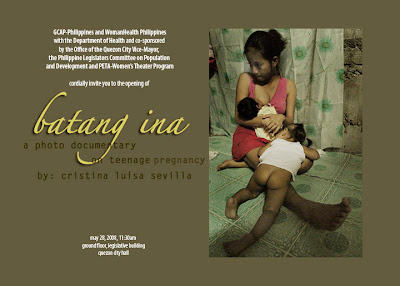Batang Ina: A Photo documentary on Teenage Pregnancy

Batang Ina
A Photodocumentary on Teenage Pregnancy
May 28, 2008
G/F Legislative Building
Quezon City Hall
Statement
As a single, childless woman, it boggles me how a child-mother can physically, mentally and emotionally handle and survive such a big change in the landscape of her life. I have seen single-motherhood happen to very close friends. I have stood beside them during their darkest nights, walked with them during those nervous hours in hospital corridors and witnessed the beautiful, joyful or solemn firsts in their children’s lives. These friends were of age, educated and part of the working middle-class. If these women, despite those numerous moments of joy with their babies, were fraught with mental, emotional and financial turmoil, what more a 12-18 year old, most probably single, uneducated and from the lower class? It is difficult to imagine the depth and breadth of their pain, nor the immensity of strength they need to survive.
As a documentary photographer, I am drawn to the complex lives that these young mothers lead. These children one day wake up and find that they are no longer children. Their childhood, the time of their lives when they should play and enjoy their youth, is suddenly altered by pregnancy. They are catapulted to adulthood with tremendous force, and they must endure it in order to lead bearable lives.
In 2000, Filipino women aged 15-24 accounted for 818,000 births. The National Demographic and Health Survey of 2003 showed that almost half of young women who are poor have already begun bearing a child compared to just over 10 percent of young women belonging to the highest income bracket. In 2004, a study made by the National Statistics Office showed that of 1.7 million babies, almost 8 percent were born to mothers aged 15-19. And in 2006, a study by the UP Population Institute and Guttmacher Institute showed that 6 out of 10 Filipino women have unintended pregnancy because of lack of access to and knowledge of modern contraceptives.
These are the statistics. And on paper, they sound alarming. But throughout doing this documentary, what I learned is that reality is even more astounding. You can walk into any poor community and find an overabundance of child mothers. Most of these girls have never seen a condom and do not even know what it is for or what it looks like at all. Most girls are unaware of protecting themselves. Once pregnant, most will give up their studies, work and worse—any hope that they will ever get out of poverty. And most will bear another child and another child and another, after their first.
Cristina Luisa Sevilla
May, 2008
Curatorial Approach
The youth is both vibrant and vulnerable. In a third world country like the Philippines, teenage pregnancy is a common problem that lays an impact on the cyclic breeding of a family of responsible citizenry. It is a reality both among the poor and the elite. It is of course more a drawback for the poor given that teenage pregnancy is something unplanned or uncalled for.
Found objects as impression of an urban poor community is then maximized to highlight a photo documentary and to call attention to the phenomena of teenage pregnancy as one step in arresting the factors causing the problem such as lack of education; profit-orientation and/or the misuse of media, internet and cellphones; extreme conservatism especially posed by the church and the macho culture (i.e. tendencies of rape or incest).
The exhibit is a call for an education that is accessible to Filipino youth and family, for a concerted effort of public and private sectors and for the youth to learn from the mistakes of their peers or the people ahead of them.
Corona Dolot - Curator
====
This photo exhibit is one of the highlights in observance of May 28 International Day of Action for Women’s Health organized by GCAP-Philippines and WomanHealth Philippines with the Department of Health, and co-sponsored by the Office of the Quezon City Vice-Mayor, the Philippine Legislators Committee on Population and Development, and PETA-Women’s Theater Program.
A Photodocumentary on Teenage Pregnancy
May 28, 2008
G/F Legislative Building
Quezon City Hall
Statement
As a single, childless woman, it boggles me how a child-mother can physically, mentally and emotionally handle and survive such a big change in the landscape of her life. I have seen single-motherhood happen to very close friends. I have stood beside them during their darkest nights, walked with them during those nervous hours in hospital corridors and witnessed the beautiful, joyful or solemn firsts in their children’s lives. These friends were of age, educated and part of the working middle-class. If these women, despite those numerous moments of joy with their babies, were fraught with mental, emotional and financial turmoil, what more a 12-18 year old, most probably single, uneducated and from the lower class? It is difficult to imagine the depth and breadth of their pain, nor the immensity of strength they need to survive.
As a documentary photographer, I am drawn to the complex lives that these young mothers lead. These children one day wake up and find that they are no longer children. Their childhood, the time of their lives when they should play and enjoy their youth, is suddenly altered by pregnancy. They are catapulted to adulthood with tremendous force, and they must endure it in order to lead bearable lives.
In 2000, Filipino women aged 15-24 accounted for 818,000 births. The National Demographic and Health Survey of 2003 showed that almost half of young women who are poor have already begun bearing a child compared to just over 10 percent of young women belonging to the highest income bracket. In 2004, a study made by the National Statistics Office showed that of 1.7 million babies, almost 8 percent were born to mothers aged 15-19. And in 2006, a study by the UP Population Institute and Guttmacher Institute showed that 6 out of 10 Filipino women have unintended pregnancy because of lack of access to and knowledge of modern contraceptives.
These are the statistics. And on paper, they sound alarming. But throughout doing this documentary, what I learned is that reality is even more astounding. You can walk into any poor community and find an overabundance of child mothers. Most of these girls have never seen a condom and do not even know what it is for or what it looks like at all. Most girls are unaware of protecting themselves. Once pregnant, most will give up their studies, work and worse—any hope that they will ever get out of poverty. And most will bear another child and another child and another, after their first.
Cristina Luisa Sevilla
May, 2008
Curatorial Approach
The youth is both vibrant and vulnerable. In a third world country like the Philippines, teenage pregnancy is a common problem that lays an impact on the cyclic breeding of a family of responsible citizenry. It is a reality both among the poor and the elite. It is of course more a drawback for the poor given that teenage pregnancy is something unplanned or uncalled for.
Found objects as impression of an urban poor community is then maximized to highlight a photo documentary and to call attention to the phenomena of teenage pregnancy as one step in arresting the factors causing the problem such as lack of education; profit-orientation and/or the misuse of media, internet and cellphones; extreme conservatism especially posed by the church and the macho culture (i.e. tendencies of rape or incest).
The exhibit is a call for an education that is accessible to Filipino youth and family, for a concerted effort of public and private sectors and for the youth to learn from the mistakes of their peers or the people ahead of them.
Corona Dolot - Curator
====
This photo exhibit is one of the highlights in observance of May 28 International Day of Action for Women’s Health organized by GCAP-Philippines and WomanHealth Philippines with the Department of Health, and co-sponsored by the Office of the Quezon City Vice-Mayor, the Philippine Legislators Committee on Population and Development, and PETA-Women’s Theater Program.


Comments